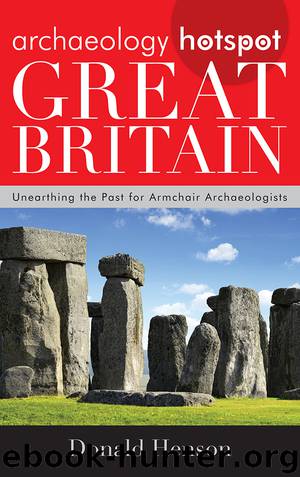Archaeology Hotspot Great Britain by Donald Henson

Author:Donald Henson [Henson, Donald]
Language: eng
Format: epub
Publisher: Rowman & Littlefield Publishers
Published: 2015-05-14T16:00:00+00:00
William Stukeley 1687–1765
One who was inspired by Aubrey was William Stukeley who did much to perfect the approach of Aubrey to the past. Stukeley was a physician and clergyman, and a fellow of both of the chief learned societies of the day, the Royal Society and the Society of Antiquaries (and a friend of Sir Isaac Newton). His approach to fieldwork, undertaken from 1718, was to record as accurately as possible and place sites in their landscape setting. Stukeley observed that burial mounds would often be sited on the crest of hills so as to be seen from the valley below. He completed Aubrey’s plan of Avebury, discovered two stone avenues leading to Stonehenge, and added the technique of excavation to his archaeological field investigations. From at least 1722, he excavated various burial mounds, observing their stratigraphy and publishing the earliest British archaeological site section. Stukeley understood that the remains of the past were fragile and that his own investigation would be part of their future history, and so left dated coins in the backfill of his excavations to help any future excavators recognize his own actions at a site. Stukeley was very firm about the need for conservation of ancient remains. He wrote against “improvers” seeking to modernize Medieval churches, and against farmers raiding prehistoric sites for building stone. His own recordings of monuments were a way of preserving knowledge of what was being lost. Stukeley even tried applying science as a way of dating sites. Assuming that Stonehenge had been built to align on magnetic north and knowing that the location of magnetic north changed over time, he deduced that the monument had been built in 460 BC. This is entirely false, but is a commendable attempt to base archaeological interpretation on scientific principles.
Unfortunately, the weakness of Stukeley was his religious faith. He sought to explain ancient stone circles and barrows as remnants of an ancient religion that connected with Christianity. To do this, he used Aubrey’s connection of such sites with the Druids and developed a theory of the prehistoric settlers of Britain coming from the Middle East after the Biblical flood and bringing with them their Jewish faith which then decayed into Druidism. He erected a complex Druidic explanation for prehistory based entirely on his imagination rather than his field observations. In later life, his lack of critical awareness would lead him to be taken in by historical frauds. How to interpret the past without an undue exercise of the imagination is still a key problem for modern archaeology. Stukeley saw scholarly endeavor as a social activity and was always searching for, or founding, societies of like-minded people, hence, his membership in the Freemasons in 1720. His attitudes could be remarkable for their time. He admitted his wife Frances as a member of one of his societies, at a time when women were normally kept firmly at home. As well as publishing works on medicine, Stukeley’s major publications include:
Itinerarium Curiosum, 1724, descriptions of monuments made
Download
This site does not store any files on its server. We only index and link to content provided by other sites. Please contact the content providers to delete copyright contents if any and email us, we'll remove relevant links or contents immediately.
| Africa | Americas |
| Arctic & Antarctica | Asia |
| Australia & Oceania | Europe |
| Middle East | Russia |
| United States | World |
| Ancient Civilizations | Military |
| Historical Study & Educational Resources |
Room 212 by Kate Stewart(4126)
The Crown by Robert Lacey(4122)
Endurance: Shackleton's Incredible Voyage by Alfred Lansing(3863)
The Iron Duke by The Iron Duke(3660)
The Rape of Nanking by Iris Chang(3537)
Killing England by Bill O'Reilly(3470)
Joan of Arc by Mary Gordon(3276)
Say Nothing by Patrick Radden Keefe(3081)
I'll Give You the Sun by Jandy Nelson(2852)
Shadow of Night by Deborah Harkness(2752)
Hitler's Monsters by Eric Kurlander(2742)
Margaret Thatcher: The Autobiography by Thatcher Margaret(2693)
Mary, Queen of Scots, and the Murder of Lord Darnley by Alison Weir(2684)
Darkest Hour by Anthony McCarten(2657)
Blood and Sand by Alex Von Tunzelmann(2617)
Red Famine: Stalin's War on Ukraine by Anne Applebaum(2474)
Eleanor & Park by Rainbow Rowell(2404)
The One Memory of Flora Banks by Emily Barr(2359)
Book of Life by Deborah Harkness(2290)
